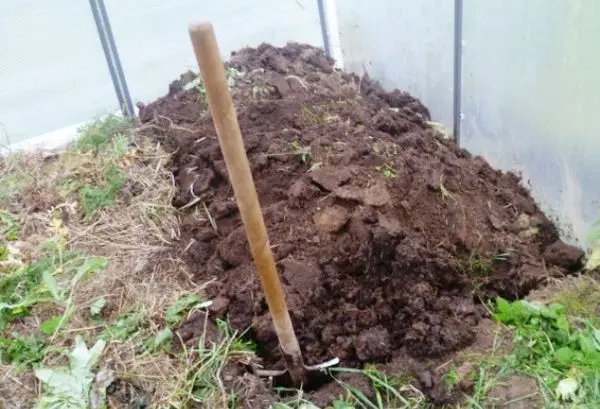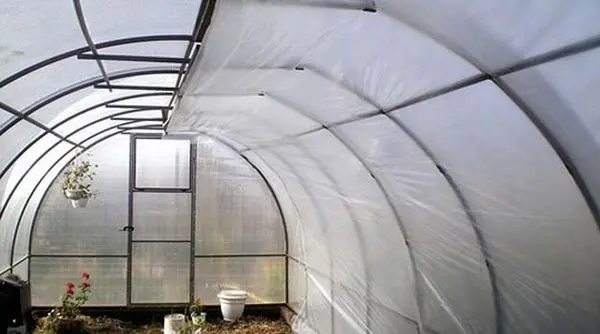Contents
Greenhouses and greenhouses reliably shelter crops from adverse weather conditions, and with adequate maintenance, significantly reduce the risk of pests or diseases. Preparing a greenhouse for winter is one of the most important maintenance procedures.
Importance of preparation
The main purpose of the greenhouse is to protect crops from cold, drafts and heavy rainfall. The design provides constant optimal conditions for the growth and fruiting of plants. However, favorable conditions are not only for plants, but also for some types of pests. Also, a warm and humid environment promotes the development of weeds, which draw useful substances necessary for planted crops from the soil. It is also possible that some fungal spores will get in, which can perfectly survive the winter and destroy the seedlings in the spring.

One of these factors may be enough to destroy the crop. Therefore, the basis for a successful future harvest is laid already in the fall through general cleaning and final processing of all parts of the greenhouse. Work on the preparation of the greenhouse is carried out in two main directions: preparing the soil on the beds for the next season and disinfecting the treatment of structural parts (framework, coating material).
Video “Preparing the greenhouse for winter”
In this video, a specialist will share recommendations for properly preparing a greenhouse for the winter period.
Spring-cleaning
After harvesting, the beds must be freed from the remnants of annual crops. In cucumbers, tomatoes, peppers, cabbage, the remaining aboveground and underground parts are removed. Also remove the remains of the fruit. It is best to burn them or bury them outside the site. With perennial crops, the situation is more complicated. They must be carefully checked, damaged, dried or rotten parts removed.
If most of the plant is damaged, then it is removed from the root. And next season, new ones are planted in their place. It is important to remove not only the remains of cultivated plants, but also weeds. Most of them are perennials, so you need to carefully check the ground for their presence.
earthworks

When growing annual crops (vegetables, berries, flowers), the topsoil must be removed annually. Replacing the soil and its further processing is the most difficult task, the result of the future harvest depends on the correct implementation of which. Usually, at least 15 cm of the top layer is removed, which, after disinfection, can be poured onto open beds, flower beds, and into the garden. Instead of the removed layer of soil, fresh fertile soil is covered. Fresh fertile soil can be purchased or prepared by yourself. Each of these options has its own advantages and disadvantages.
Buying ready-made soil is faster and easier, but you cannot be completely sure that it contains all the necessary useful components. There are times when land taken from another greenhouse is sold as new soil. This option is completely unprofitable: the soil is not only completely depleted, but can be infected with a pest or fungal spores.
The second option is to prepare the soil yourself. It is more labor-intensive and will take longer, as the soil must meet certain criteria: the correct structure, a high degree of nutrition, the absence of mineral salts, a neutral pH level, a level of moisture capacity. The classic composition of the soil for a greenhouse consists of peat of a raised formation, river or lake sand, compost or humus.
disinfection
Pests and spores of fungi perfectly tolerate winter in the heifer. Their place of refuge can be not only the soil, but also the details of the structure. That is why disinfection should be carried out comprehensively.
Soil cultivation
According to the advice of experienced gardeners, it is necessary to disinfect the soil in three proven ways: treat with bleach, fumigate with sulfur, and spray with a special solution. The bleach is scattered over the bed and spread over the ground with a deep rake. For fumigation, sulfur is mixed with kerosene and set on fire in the far corner towards the exit. After that, the greenhouse is closed for several days.
You can also use sulfur checkers. Sulfur fumigation is only suitable for tall structures with non-metal frames, as the fumes emitted can cause metal corrosion. Diluted copper sulphate, aqueous formalin, lime (4%) and creolin (2%) are suitable as a spray solution.
Frame and cover
During sulfur treatment, not only the soil is disinfected, but also all parts of the greenhouse. Frames are processed depending on the material from which they are made. Metal is washed with boiling water with the addition of vinegar, painted over with enamel. PVC can also be treated with acetic solution, but with a temperature not exceeding 60 ° C. For wooden frames, it is recommended to use copper sulfate (10% solution).
Coating processing also depends on the material. The plastic film is washed with soapy water, disinfected with copper sulfate and dried. Glass can also be treated with a solution of a bar of soap (with a high percentage of alkali) and boiling water. Polycarbonate cannot be processed with active alkali. It is recommended to use an intense hot solution of potassium permanganate.
It is important to thoroughly rinse all hard-to-reach places where danger in the form of infections or pest larvae can hide. After disinfection, the greenhouse must be dried and ventilated.
Sowing useful plants
To disinfect the soil, fertilize it and improve the structure, green manure is planted in the ground in the fall. You can use white mustard, vetch, phacelia. The grown green manure is left for the winter without being embedded in the soil, although some gardeners prefer to prune the plants and cover them with soil for the winter.
Warming
If you plan to use the greenhouse in winter, you need to take care of its insulation. Depending on the type of construction and covering material, you need to choose the best insulation method for your greenhouse.

Fundamental rules
To ensure comfortable conditions for plants and not damage the structure, it is necessary:
- strengthen the frame;
- insulate all parts of the greenhouse (foundation, vestibule or door area, and the entire structure as a whole);
- use the best option for your type of greenhouse (heating, air gap, insulation with foamed polystyrene);
- take care of the disinfection of materials used for disinfection.
Materials
Greenhouses are insulated in various ways and materials. For glass and polycarbonate greenhouses, heating systems are used whenever possible. A more economical option is insulation with foamed polystyrene, another layer of film or polycarbonate with an air gap. In the off-season, you can use plastic water bottles lined up in rows, which during the day, thanks to the sun’s rays, will absorb heat, and at night – give it away.
Do not be too lazy to prepare the greenhouse for winter in the fall in accordance with all the rules, and you are guaranteed an excellent harvest!









